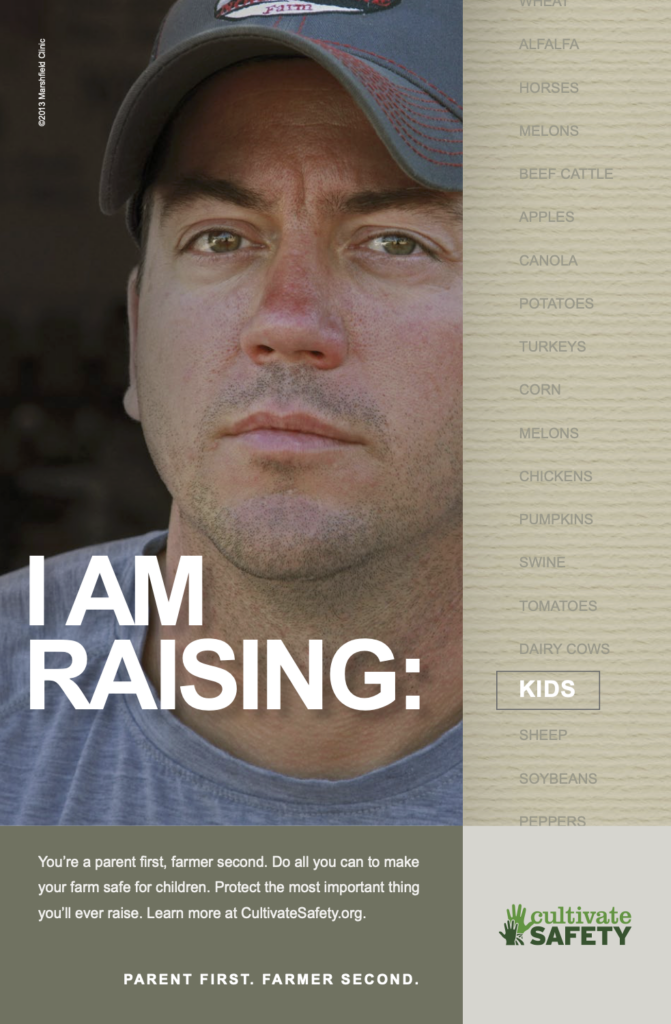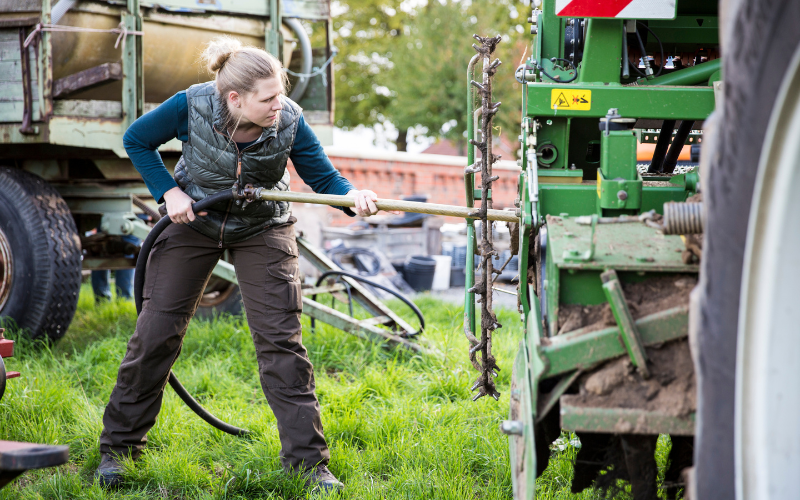
It Happened to One of Us
2016 Incident Summary
(Incident source: Alberta Government, March, 2018). Investigation Report Worker Fatally Crushed by Equipment. Open.alberta.ca. Accessed June 21, 2023 from https://open.alberta.ca/dataset/42e9208b-503f-4e6e-a5f9-88c7097b58b5/resource/c805cc1c-ac4c-4fc9-ae56-ba7c6f81480e/download/16-08-30northwestmowingreportpublic-002.pdf

In late August, a worker who had been hauling oats to a farm in northern Alberta was found trapped between the frame and the box of the grain truck he had been using.
The worker had been transferring oats from the box of the grain truck into bins. The worker either lifted the grain box using the hydraulic lift switch inside the cab or the hydraulic lift switch located on the passenger side frame behind the cab. A short time later, the employer came into the yard and could hear the auger running but could not see the worker. When he approached the driver’s side of the grain truck, he could see the worker trapped between the frame and the box of the grain truck.
The employer then used a tractor to lift the grain box up enough that the worker fell to the ground (he did not recall if the grain truck had been running or why he did not attempt to engage the hydraulic lift on the grain box). The employer administered first aid to the worker, but the worker was unresponsive. The employer shut off the auger and tried to call 9-1-1 from his cell phone but kept losing service. He then went to the house to call 9-1-1, then went back to the scene and continued to administer first aid until EMS and RCMP arrived.
Following the incident, a function test of the hydraulics was performed, and the employer was able to lift the grain box (which still had a full load of oats) and maintain a hold without the box lowering. RCMP evidence provided to OHS indicated that a small child was removed from the cab of the vehicle by the employer when he arrived on site.
This incident is particularly tragic and details are limited.
Each harvest places many demands on farm families, and there are times where we need to recognize our roles as parents and producers as being distinct and separate. Never forget that a child’s brain is not fully developed yet, resulting in varying degrees of impulsive behaviour and a lack self-control. Unexpected things can occur, resulting in your attention being taken off task by your child or your attention being taken off your child by the task. Before bringing a child with you to get a job done, take some time to seriously think about how appropriate and safe it will be for you, them and anyone else who may be in the work area.
Creating Safe Play Areas

Balancing work and family obligations can be challenging, especially during busy times like harvest. While there is no substitute for good, watchful supervision, another thing that can help protect children is the creation of a safe play area.
Many farms already have an outdoor play area, but they have likely not been designed for safety or checked for potential hazards. When we talk about planning for safety, we are not talking about bubble-wrapping children and preventing bumps and bruises; what we are talking about is ensuring that a child doesn’t get strangled by their clothing on a slide, have a heavy play structure tip over onto them, or leave the area and fall into a dugout or run in front of a full grain truck that will not be able to stop fast enough.
Review the National Children’s Centre for Rural and Agricultural Health and Safety’s publication, Creating Safe Play Areas on Farms to learn what to think about and what you can do.
Keeping Our Kids Safe on the Farm

Making farm safety clear and easy to understand isn’t always simple, especially when explaining it to children. Luckily, there are many great resources focused on farm safety for children. Click on the links below to help you find suitable resources for your children:
The Farm Safety Centre has games, videos and activity sheets for children.
The Childhood Agricultural Safety Network has resources for both younger and older children.
For resources geared towards youth and young adults working on the farm, visit agsafeab.ca.

Important Factors to Consider When Working Alone

Someone is considered to be working alone when they cannot be seen or heard by someone else, and assistance is not readily available to the worker should there be an injury, illness or other emergency. Working alone often happens in agriculture and is a risk that needs to be managed. Consider the following points before someone works alone on your farm:
- Should the person be working alone at all? Think about what could go wrong and how bad the outcome could be (i.e., identify the existing and potential hazards, then assess them for risk; you can refer to the AgSafe Alberta FarmSafe Plan Manual for help with this).
- Does the person have the training, experience, skill and ability to work safely without supervision or anyone else nearby?
- Is the person reasonably healthy and fit? Do they have an injury or illness that could impact their ability to work alone safely? Are they taking any medications that may affect their thinking, motor skills or how extreme temperatures may affect them, etc.?
- Is this person a new, older or young worker? Remember, new and young workers have unique work factors that will affect their ability to work safely.
- What is a reasonable length of time for the person to be working alone for and how long will or could the job take? How often will someone need to check in on them? Will the check in be done visually or verbally?
- What time of day will the person be working alone, (e.g., early in the morning, late at night, in dark or during the hottest time of the day)?
- Is it reasonable for the person to be alone? No one should be working alone in a confined space (e.g., septic tank) or on machines that need to be locked out and tagged out.
- Is there a tested form of communication in place that will work as needed in all situations?
- If the communication system is in a vehicle or piece of equipment, is another form of communication needed when the person is outside of the vehicle or equipment (e.g., performing repairs on the equipment)?
- Does the work area, vehicle or equipment have the necessary emergency supplies, such as food, water, a first aid kit and a fire extinguisher? Is the person working alone trained to use the first aid equipment available to them?
- How far away from someone else is the person working alone? Is it a few yards in a building or is it several kilometres?
- If someone needs to get to that location and help the person who has been working alone, is there a form of transportation available that will allow the person to be brought back if needed? Is the check-person trained in first aid?
- Does the farm have emergency action plans that can be followed in the event of an emergency? Is there a transportation plan in place and ready to use should a person who has been working alone require transport to the nearest hospital?
You can share this information with your farm team by downloading and printing the AgSafe Alberta Toolbox Talk Important Factors to Consider When Working Alone.
Create a working alone plan today using this sample template Working Alone Plan Sample 01.
If you missed it last month, you can also use AgSafe Alberta’s Worksite Emergency Transportation Plan.

Wildfire Smoke Resources

Parts of Alberta are continuing to struggle with wildfire smoke late into the season. If your operation is impacted by wildfire smoke, check out the resources below:
Government of Alberta’s Wildfire smoke OHS information for employers and workers
AgSafe BC’s Working in Smoky Conditions Video
My Health Alberta’s Wildfire smoke and your health
WorkSafe BC’s Wildfire Smoke FAQs
Safety First, Last Thoughts
What is a Toolbox Talk?
A toolbox talk is a short (5 to 10 minutes) informal meeting with your family members, farm workers and even contractors before work begins. Toolbox talks are a quick overview of specific workplace hazards, safe work practices, facts, and other safety-related considerations. These are best when performed at the job site (where the work will be performed) and should encourage discussion and participation by the people present.
The benefits of toolbox talks include:
- Promoting safety awareness.
- Introducing workers to new safety rules or safe work practices.
- Reinforcing important safety related topics, such as work-related hazards.
- Providing opportunities to review important safety related information, such as standards, emergency related procedures, etc.
Visit the Alberta Resources Page on our website to find toolbox talks you can use on your operation.
CONTACT US
For general inquiries: info@agasafeab.ca /403-219-
For our hotline for incidence assistance: 1-833-9AGSAFE
